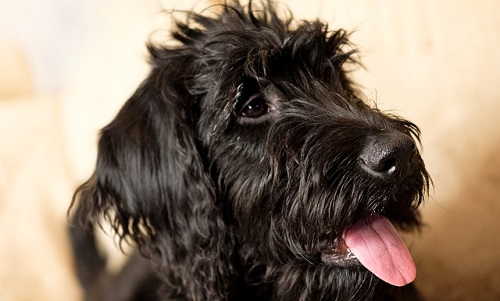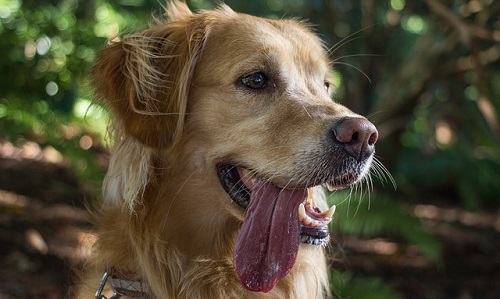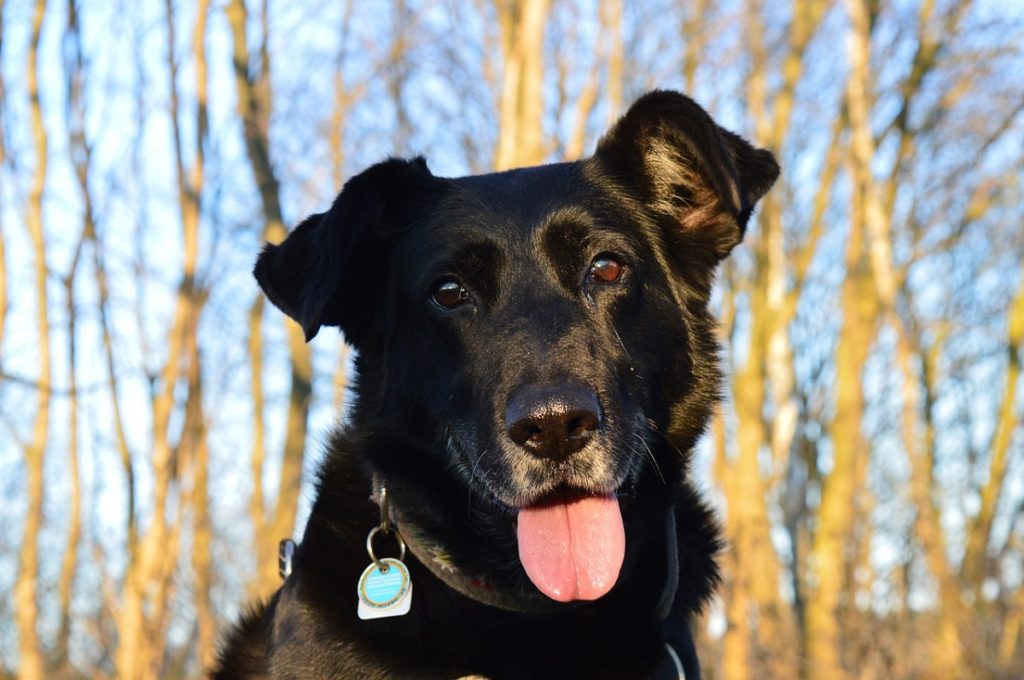Fast-paced, heavy breathing is typically accompanied by an open mouth and a tongue hanging out, the latter of which is much more common to canines than their out-of-breath human companions. So why don’t they simply breathe through their noses, and why do they pant in some conditions but not in others? The answer is more complex than you might think.
Understanding Dog Panting
- To Cool Off: A dog panting is more than an animal trying to get air into the lungs after strenuous exercise or respiratory distress, it’s also primarily a method of cooling the body in warm weather. While it’s obviously important to have plenty of air to breathe, dogs can quickly overheat in higher temperatures, which can lead to a canine heat stroke; it’s one of several reasons that owners are cautioned never to leave their canine companions in a hot car.
 Dogs, the vast majority of which are completely covered in fur, don’t have the dubious luxury of sweating like people do. Instead, these four-legged friends need to consciously expel heat in other ways, and that means using what they have at their disposal: their uncovered paw pads and their breathing. While dogs can “sweat” through their paw pads, these cover relatively little surface area as compared to the rest of their body, so a secondary method is needed: panting pushes hot air out and pulls fresh air in, circulating it to keep your pup cool from the inside out.
Dogs, the vast majority of which are completely covered in fur, don’t have the dubious luxury of sweating like people do. Instead, these four-legged friends need to consciously expel heat in other ways, and that means using what they have at their disposal: their uncovered paw pads and their breathing. While dogs can “sweat” through their paw pads, these cover relatively little surface area as compared to the rest of their body, so a secondary method is needed: panting pushes hot air out and pulls fresh air in, circulating it to keep your pup cool from the inside out.
- To Tell You They’re Having a Good Time: Believe it or not, dogs can actually smile and laugh! Their laugh sounds very different than a human chuckle, however – owners of happy pups report the canine laugh sounds like short bursts of panting, rather than the constant rhythm exhibited by overheated or tired dogs. Dogs showing this happiness may also keep their mouths open – teeth not shown – because they feel safe. The gesture functions as a sort of doggie smile that doesn’t hide one of their more vulnerable areas, the neck.
The key to determining whether your furry friend is panting because he’s happy (versus scared or warm) is to watch the rest of his body language: if his tail is wagging, his body is relatively relaxed, and his ears aren’t pinned, chances are he’s just happy to see you and ready to play!
- Because there’s trouble nearby: When humans are put in a situation that gets their adrenaline up – a fast ride at a fair, a verbal argument, running late and needing to rush – they can mostly keep their heart rate a secret. Your pet isn’t quite as adept at concealing his excitement, and often pant when he’s stressed or anxious. This physical expression of stress or anxiety in dogs serves as a signal to their wild pack mates that trouble is nearby and that it’s time to flee or fight. It may also be a way to ensure they have enough oxygen to face off against a predator, or to run quickly to avoid one.
Just as body language tells the story when looking for “happy” panting, it will also confirm alert-anxious panting. If your dog looks to be hyper alert, staring at a potential threat with their muscles tensed, they may be bracing to defend you or their territory. Reassure them by keeping short, jerky movements to a minimum and maintaining your voice at a normal, calm level and tone.
- Because they’re frightened: Dogs don’t have the benefit of a weather report to alert them to looming storms, or a calendar to tell them the fireworks outside are for a holiday. Loud noises, lights, and changes in environment can prompt physical stress in your dog, leading him to pant. It’s the same triggers found in anxiety, but fear-panting is much easier for an owner to alleviate. Usually accompanied by “cringing” behaviors like hiding the face, drooping the ears, or trying to hide behind legs or furniture, a comforting presence goes a long way towards helping.
If your dog fear-pants often, there’s likely something in their environment causing ongoing stress. This may be the presence of another animal, a lack of security where the dog typically lays down to sleep, loud children, or frequently changing environments. Consider the panting a red flag and try to locate and remove the cause if at all possible – it’s the best move for your pet’s well-being.
- Because of their breed: Dogs belonging to “flat-faced” breeds are considered brachycephalic, a medical term that essentially means they have breathing issues due to the shape of their face. Dogs in this classification include Boxers, Boston Terriers, Bulldogs, and Pugs, as well as smaller breeds like Shih Tzus. Due to the shape of the skull in these breeds, the nostril nares are often shortened, and breathing issues can result due to mouth formation issues, such as an enlarged tongue or drooping soft palate. Older dogs in these breeds are particularly susceptible to canine breathing issues, and many undergo surgery for correction of those that emerge as they grow older.
While these breeds will likely always have similar issues, alert owners can make their dogs much more comfortable with a little pre-planning. Treat exercising and heat exposure for brachycephalic breeds the way you might fair skin in the sun – short bouts with a watchful eye for any dangers. Vets also often recommend owners to use harnesses around these breeds as opposed to collars, which can further restrict the airway and lead to more panting.
Do Dogs Pant When They’re Sick?
 While a dog won’t necessarily pant every time he is sick, your dog’s behavior is a pretty good indication that an underlying condition may be present. Humans have muscles that allow them to cough with relative ease when compared to canines, so people don’t tend to pant unless their in respiratory distress. Dogs, while they can cough, have a harder time doing so voluntarily, thus illnesses can be very uncomfortable for them. Panting, in addition to regulating the body temperature, can offer a soothing, rhythmic cycle for an ill dog, helping them to rest and regain their strength. Panting can also point to more serious issues, however, so be on the lookout for these warning signs:
While a dog won’t necessarily pant every time he is sick, your dog’s behavior is a pretty good indication that an underlying condition may be present. Humans have muscles that allow them to cough with relative ease when compared to canines, so people don’t tend to pant unless their in respiratory distress. Dogs, while they can cough, have a harder time doing so voluntarily, thus illnesses can be very uncomfortable for them. Panting, in addition to regulating the body temperature, can offer a soothing, rhythmic cycle for an ill dog, helping them to rest and regain their strength. Panting can also point to more serious issues, however, so be on the lookout for these warning signs:
- Discolored gums or tongue: If your pup is panting and you notice that their gums, tongue, or inner mouth looks blue (less blood circulation than they need) or overly red (inflamed or infected), the panting is likely secondary to another medical issue.
- Panting when resting and relaxed: If your dog doesn’t have an existing illness and you notice them panting quickly, wheezing, or in respiratory discomfort, they’re having other health problems that definitely need to be looked at by a vet. If you and your dog are comfortable doing so, you can also gently put your ear against their side to listen for wheezing or crackling when he breathes.
- Panting after exposure to something dangerous: If you’re worried that your dog has “gotten into” something they shouldn’t have and consumed it, panting is a sign their body is having difficulty processing it. If you suspect your dog has ingested something harmful, don’t wait – head right for the nearest emergency vet and make sure your dog isn’t in immediate danger. Remember, even innocent-seeming foods such as raisins or chocolate can be harmful or deadly to most dogs!
- Panting after a change in diet or environment: Humans can develop rashes or asthma attacks when new scents or chemicals are introduced to the home, such as laundry detergent, air fresheners, or cleaning products. Dogs are no less sensitive, so if you’re planning on switching to a new detergent or cleanser, keep an eye on your dog for signs of panting and discomfort. This is particularly true if said chemicals will be in their bedding or where they typically lay down to rest. If you need to narrow down potential allergens, try switching to a scent-free detergent for bedding and clothes temporarily to see if your dog’s breathing improves.
- Panting during very hot weather. All the fur your dog has on his body is intended to keep him warmer in the winter and cooler in the summer, but sometimes very high temperatures win out. Different breeds and different coats can handle certain temperature ranges, while others can’t – as a pet
 parent, you need to learn your dog’s temperature comfort zone.
parent, you need to learn your dog’s temperature comfort zone.
If he’s panting heavily and seems a little dazed, bring him immediately into a temperature-controlled area (preferably one with air conditioning) to cool off. Additionally, your dog should have access to cool, clean water at all times during hot weather – it helps them beat the heat the same way that panting does. It takes far less time for your dog to overheat in the sun than it will for you, so if you’re uncomfortably warm, don’t wait!
My Dog is Panting Really Loud: How Do I Stop It?
Panting is a natural and healthy behavior for dogs, but for pet parents it can also be a loud, distracting behavior. If you’d like to stop your dog’s loud panting, try these techniques:
- Check his water: is his water bowl full? If he’s thirsty or hot, the panting will likely only get louder. If you’ll be away from the house for a few hours, try putting a handful of ice cubes in his water bowl to keep the water comfortably cool for him. Your dog should ideally have access to a temperature-controlled area for comfort, and covered shelter at a minimum in non-extreme temperatures.
- Check his temperature: is it very warm in the house or outdoor area that they’re sitting in? If you need a fan or air conditioning, chances are very good that your dog does, too. If you’re driving with your pet, turn up the AC or crack a window, being careful to keep a gap too small for your pooch to fit through. If you’re at home, consider setting up his bed closer to an air conditioner or fan.
- Check his environment: are there loud, unfamiliar noises or objects nearby? Are there children or other pets present that could be causing him undue stress? If possible, set up a resting spot for your dog in a quiet corner or another room so he isn’t feeling threatened.
In addition, here are some helpful tips to keep in mind when addressing your dog’s rapid breathing:
- Offer him distractions: Dogs need something to do, particularly if their humans are busy and wrapped up in smartphone or computer usage. Your dog could be panting to try to initiate fellowship and play – obviously, the best course is to sit with him and play, but with a busy schedule, this isn’t always possible. Consider giving him a favorite bone or toy to chew on until you can sneak away from chores or work for a few minutes to spend with him.
- Adjust his diet: If you’ve just started a new dog food and your furry pal has started panting right after mealtime, your dog may be allergic to his food. Loss of appetite is another symptom that may also indicate a food allergy. Try to stick to a familiar, high-protein diet unless instructed otherwise by a vet, and use a few high-quality supplements to keep your dog’s health at peak performance.
- Bring him to a vet: If you own a flat-faced breed dog, there’s a chance that surgery may be necessary to correct a breed-specific breathing issue. This is particularly true if your dog is older, as age tends to aggravate many of the breathing and panting issues experienced by this range of breeds. Your vet will be able to tell you if genetics is the culprit of your dog’s difficulty breathing and give you some solutions to alleviate the excessive panting.
Summary
Panting is one of the many ways your dog “speaks” about his comfort level, wishes, and needs – are you listening? Don’t wait for a health crisis to figure out why your dog is panting and if you should be concerned about it – and if you do feel your dog’s panting is excessive enough to warrant a professional examination, don’t hesitate to call your trusted veterinarian. However, for most healthy dogs, panting is simply a result of being a little excited or overheated and nothing serious to worry about.
Sources Cited:
- “Why Do Dogs Pant?” PetMD.com, (no publish date), https://www.petmd.com/dog/behavior/evr_dg_why_do_dogs_pant. Accessed December 27, 2018.
- “Why Is My Dog Panting Heavily?” Pets.WebMD.com, (no publish date), https://pets.webmd.com/dogs/dog-panting-heavily#1. Accessed December 27, 2018.
- Darroch, Laurie. “Why Is My Dog Panting Heavily?” Canidae.com, August 8, 2017, https://www.canidae.com/blog/2017/08/why-is-my-dog-panting-heavily/. Accessed December 27, 2018.
- Schamble, Melody. “Why Do Dogs Pant?” AKC.org, May 26, 2016, https://www.akc.org/expert-advice/health/why-do-dogs-pant/. Accessed December 27, 2018.
- Ward, Dr. Ernie. “Health Issues for Brachycephalic or Flat-Faced Dogs.” Dogster.com, September 27, 2017, https://www.dogster.com/dog-health-care/health-issues-for-brachycephalic-flat-faced-dogs. Accessed December 27, 2018.




